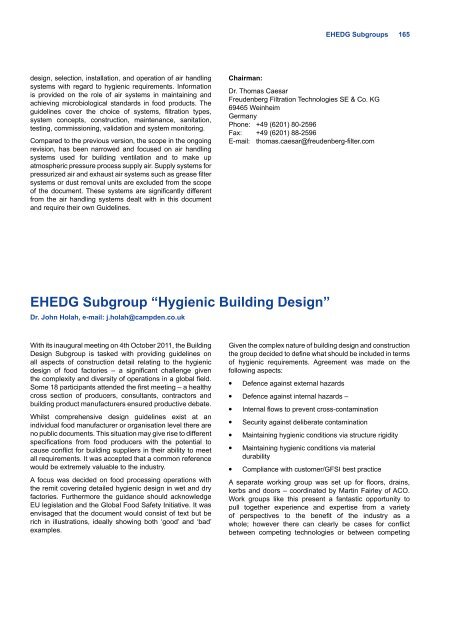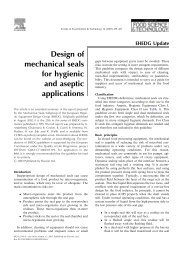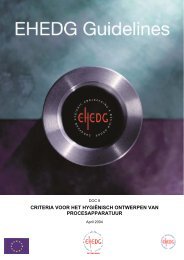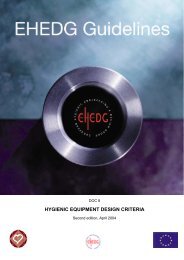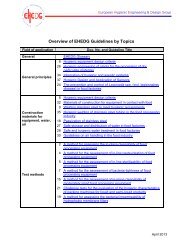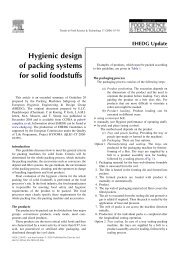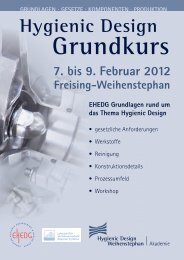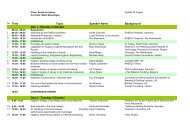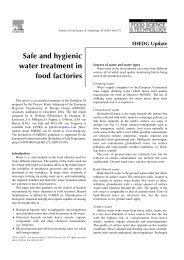Yearbook 2013/2014 - ehedg
Yearbook 2013/2014 - ehedg
Yearbook 2013/2014 - ehedg
Create successful ePaper yourself
Turn your PDF publications into a flip-book with our unique Google optimized e-Paper software.
EHEDG Subgroups 165<br />
design, selection, installation, and operation of air handling<br />
systems with regard to hygienic requirements. Information<br />
is provided on the role of air systems in maintaining and<br />
achieving microbiological standards in food products. The<br />
guidelines cover the choice of systems, filtration types,<br />
system concepts, construction, maintenance, sanitation,<br />
testing, commissioning, validation and system monitoring.<br />
Compared to the previous version, the scope in the ongoing<br />
revision, has been narrowed and focused on air handling<br />
systems used for building ventilation and to make up<br />
atmospheric pressure process supply air. Supply systems for<br />
pressurized air and exhaust air systems such as grease filter<br />
systems or dust removal units are excluded from the scope<br />
of the document. These systems are significantly different<br />
from the air handling systems dealt with in this document<br />
and require their own Guidelines.<br />
Chairman:<br />
Dr. Thomas Caesar<br />
Freudenberg Filtration Technologies SE & Co. KG<br />
69465 Weinheim<br />
Germany<br />
Phone: +49 (6201) 80-2596<br />
Fax: +49 (6201) 88-2596<br />
E-mail: thomas.caesar@freudenberg-filter.com<br />
EHEDG Subgroup “Hygienic Building Design”<br />
Dr. John Holah, e-mail: j.holah@campden.co.uk<br />
With its inaugural meeting on 4th October 2011, the Building<br />
Design Subgroup is tasked with providing guidelines on<br />
all aspects of construction detail relating to the hygienic<br />
design of food factories – a significant challenge given<br />
the complexity and diversity of operations in a global field.<br />
Some 18 participants attended the first meeting – a healthy<br />
cross section of producers, consultants, contractors and<br />
building product manufacturers ensured productive debate.<br />
Whilst comprehensive design guidelines exist at an<br />
individual food manufacturer or organisation level there are<br />
no public documents. This situation may give rise to different<br />
specifications from food producers with the potential to<br />
cause conflict for building suppliers in their ability to meet<br />
all requirements. It was accepted that a common reference<br />
would be extremely valuable to the industry.<br />
A focus was decided on food processing operations with<br />
the remit covering detailed hygienic design in wet and dry<br />
factories. Furthermore the guidance should acknowledge<br />
EU legislation and the Global Food Safety Initiative. It was<br />
envisaged that the document would consist of text but be<br />
rich in illustrations, ideally showing both ‘good’ and ‘bad’<br />
examples.<br />
Given the complex nature of building design and construction<br />
the group decided to define what should be included in terms<br />
of hygienic requirements. Agreement was made on the<br />
following aspects:<br />
• Defence against external hazards<br />
• Defence against internal hazards –<br />
• Internal flows to prevent cross-contamination<br />
• Security against deliberate contamination<br />
• Maintaining hygienic conditions via structure rigidity<br />
• Maintaining hygienic conditions via material<br />
durability<br />
• Compliance with customer/GFSI best practice<br />
A separate working group was set up for floors, drains,<br />
kerbs and doors – coordinated by Martin Fairley of ACO.<br />
Work groups like this present a fantastic opportunity to<br />
pull together experience and expertise from a variety<br />
of perspectives to the benefit of the industry as a<br />
whole; however there can clearly be cases for conflict<br />
between competing technologies or between competing


